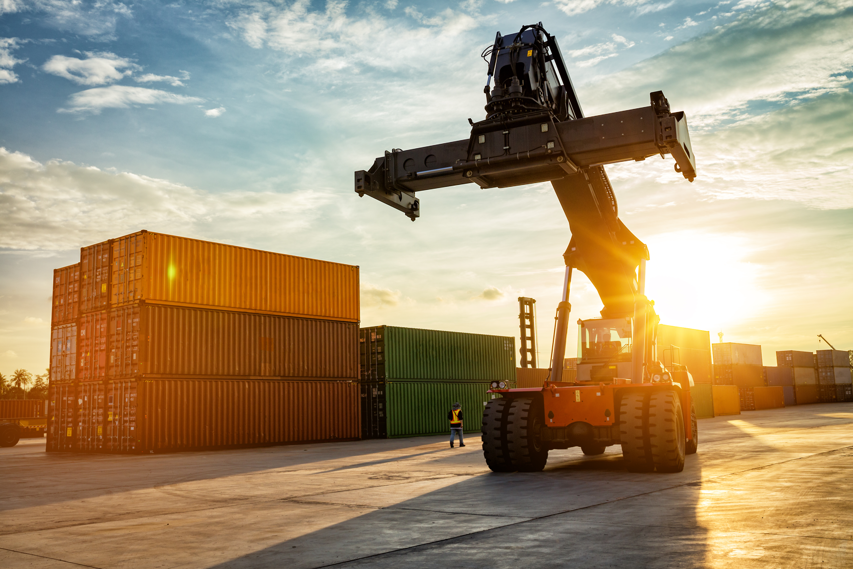Not all transport companies operate the same way. Some manage 600-meter trains, others handle empty containers in rapid in-and-out cycles, and many must coexist with legacy systems, Excel spreadsheets, and manual processes that can no longer keep up. Most share a common issue: They want to digitize their operations without slowing down activity, starting from scratch, or relying on off-the-shelf solutions.
Essentos addresses this need with a clear proposition: A modular operating system for logistics terminals, capable of adapting to any type of infrastructure, process, or digital maturity. From an intermodal rail terminal to a dry port or an empty container depot, Essentos enables you to digitize the essentials first (Gate, Weighing, Yard, and Analytics) and then evolve without redoing everything.
This guide outlines all the types of clients who can implement Essentos, explaining their challenges, operational logic, and how our modular approach allows them to move forward without disrupting what already works. It’s designed for terminal managers, operations directors, logistics consultants, and CIOs seeking clarity on what can be done, how, and with what real-world results.
If your company is looking for a practical, secure, and scalable way to modernize its operations, keep reading. There’s no smoke here, just real cases, clear answers, and a solution already delivering results in Europe and Latin America.
Intermodal rail terminal
The train-truck mismatch
A train arrives with 60 wagons. 180 trucks are waiting. If the manifest doesn’t match reality, the first hook-up is delayed.
License plates are written down by hand and the VGM is printed on paper. The supervisor checks three different screens and still loses traceability.
The reach stacker searches for a container that isn’t where the PDF indicated. The line grows. The train driver argues over the radio. Minutes are lost.
Direct impact on margins
Each extra minute costs €1.15. A train delayed by 40 minutes adds up to €46 per container in delays and fuel.
Punctuality KPIs drop from 92% to 78%. The shipping line threatens to divert the service to another ramp.
The lack of reliable data prevents shift planning. Staff work overtime and labor costs rise by 14%.
Essentos synchronizes every link
Gate + SecurePass validates the license plate and booking in 2 s. The truck receives an exact time slot and proceeds to the assigned lane.
Weighing seals the VGM and sends it to the Operations module without double entry. Operations generates the loading task for the correct railcar.
Plus displays real-time progress. If the pattern deviates, the system notifies the yard manager and adjusts the queue.
Real case
At one terminal, Essentos reduced truck dwell time from 68 min to 41 min. The train completed loading 34 min earlier.
Location errors dropped from 7% to 0.3%. ROI was achieved in 21 operating days.
Dry port / inland terminal
Duplicated processes, lost traceability
The seaport sends an EDI manifest. The inland terminal prints it to check manually. The error arrives with delay.
A reefer container shows up without temperature data. The operator searches the email for the order. The customs office closes in 40 min.
Hidden costs, irritated clients
Double data entry consumes 2 hours daily from one admin. Customs applies a surcharge for incomplete data.
The client calls three times to find out where their cargo is. Time is wasted, and trust is lost.
Clean data from port to port
Connect translates the EDI into semantic events. Gate verifies and enriches incoming data. Weighing certifies the weight without the driver leaving the truck.
Plus gives the shipping line real-time access. Customs sees the timeline and releases the cargo without extra inspection.
Measurable result
A Latin American inland terminal went from 5 days to 1 hour to reconcile physical vs. document inventory.
Customs surcharges were eliminated and the shipping line increased volume by 18% in two months.
Multipurpose port terminal
Diverse cargo, parallel processes
Monday: containers. Tuesday: bulk. Wednesday: Ro-Ro. A rigid system forces different spreadsheets for each type.
The crane operator checks an Excel file; The Ro-Ro team uses radio. No one sees the full picture. Moves are duplicated.
Operational chaos and hidden cost
The Ro-Ro vessel waits because the dock is occupied without notice. The container misses its train slot.
The billing per ton of bulk doesn’t match the scale. 3% of revenue is lost.
Real modularity, not theoretical
Gate handles any vehicle. Operations creates specific queues. The cargo profile defines the rules.
The operator sees a single dashboard. If the mode changes, the system adapts logic without restarting anything.
Mediterranean port
Started with Gate and Weighing for containers. In 3 months, it added Ro-Ro and solid bulk without halting operations.
Today it handles 8 types of cargo through a single digital flow and reduced rehandling by 18%.
Private industrial terminal
Production and logistics without dialogue
A steel mill generates 20 railcars a day. Departure depends on external schedules, but there’s no real visibility.
The ERP orders the shipment of 1,000 tons, but doesn’t know if the track is clear or if there are trucks for last-mile delivery.
The weighing is manual, the delivery note is signed on paper, and no one can prove the exact dispatch time.
Costs and bottlenecks
The shift halts due to lack of track space. The plant slows down without knowing if the train has left.
Delays lead to contractual penalties. Carriers switch to other providers.
Production connected to real logistics
Essentos connects the plant with the rail yard. Each batch has a digital ID from origin to destination.
Weighing transmits the load to the railcar. Operations validates track availability. Dispatch adjusts in real time.
Plus provides time-stamped traceability. The ERP stops guessing. The train doesn’t wait. Neither does the truck.
Ceramics industry
Buffer storage dropped 27% thanks to synchronization. Trains always departed within their scheduled window.
Delay penalties were eliminated. The plant gained 1.8 days/month in logistics capacity.
Urban multimodal logistics hub
Congestion, noise, and limited windows
In urban areas, access is restricted. Deliveries must meet scheduling and emissions regulations.
An urban terminal receives night trains and dispatches within 4-hour slots. If the truck doesn’t show, the slot is lost.
Neighbors complain about noise. The operator needs data, not excuses.
Errors that multiply
A single booking error delays 20 deliveries. The train returns with cargo. Margin drops by half.
The authority imposes new limitations. The customer doesn’t return.
Urban precision and traceability
Gate assigns exact slots. SecurePass prevents queues. Plus monitors timing.
Essentos shows who’s coming, with what cargo, when they arrive, and how long they take.
The system adapts to the environment without losing agility.
Metropolitan terminal
Reduced neighbor complaints by 71%. Meets 96% of logistics windows. The authority doubled its licenses.
Mixed logistics terminal (road + rail)
Two worlds, zero coordination
The train arrives. The warehouse isn’t expecting it. The truck leaves. The cargo gets stuck in the middle.
Yard systems don’t “talk” to the road TMS. The worker fills out Excel sheets.
Inventory goes out of sync. No one knows if a pallet or an entire container is missing.
Hidden costs from every disconnection
4% of the cargo undergoes double handling. Unit cost rises without anyone noticing.
Multimodal contracts lose efficiency. The customer seeks more agile operators.
A single thread for the entire operation
Essentos unifies rail and road. Orders are translated into physical tasks, visible in Plus.
The operator knows if the truck is arriving, if the train is leaving, and what cargo goes in which mode.
No duplicate entries. Everything flows from gate to final warehouse.
3PL logistics
Synchronized modes and cut idle time by 22%. Increased monthly volume without expanding facilities.
Empty container depots, logistics activity zones (ZAL), and warehouses connected by rail
Empty container depots: How to digitalize silent chaos
Although they’re usually invisible to the end customer, empty container depots are an essential part of the logistics cycle. Here, containers are inspected, repaired, cleaned, and stored until their next assignment. The problem is that many still operate with fully manual processes, paper records, or generic software that doesn’t understand container logic.
This causes input errors, duplicated exits, conflicts with shipping lines, and an inability to plan available space. As volume grows, so do congestion and conflicts. Operating costs skyrocket, and the client loses visibility over actual inventory.
Essentos adapts its operational core to these facilities, enabling full control of every movement — gate in and gate out — with digital traceability from the very first step. Operators can record inspections, repairs, or assignments directly from a phone or tablet, while managers access dashboards showing availability, rotation, and occupancy by shipping line or container type.
Plus, thanks to its modular architecture, automatic weighing or OCR cameras can be integrated without developing new platforms. Everything flows through a single operational system, built so information moves without duplication and without the need to consolidate Excel sheets.
The result is simple yet powerful: more rotation, fewer errors, total visibility, and reduced repetitive tasks that used to require two people per shift just to manage paper sheets.
ZAL: Turning fragmentation into connected efficiency
Logistics Activity Zones (ZAL) bring together warehouses, logistics operators, customs services, and multimodal platforms in the same environment. This coexistence creates opportunities, but also significant challenges: multiple actors, different systems, cross-traffic, and shared infrastructure that must be coordinated efficiently.
Many operators lose visibility over actual cargo traceability, effective use of access points, or the load status of a convoy located inside the ZAL but outside their direct perimeter. This causes overlaps, conflicting priorities, and growing difficulty in scaling operations frictionlessly.
Essentos allows specific modules to be deployed in each ZAL area (gate, yard, weighing, analytics), integrating all data into a shared system that remains fully segregated by user or company. Each operator sees only their own scope, while the logistics authority or global manager has a real-time holistic view.
With its role and permission system, it’s possible to manage from a single instance different operators, internal routes, access points, or time windows — applying differentiated usage rules by customer, sector, or type of cargo.
In zones where major e-commerce platforms, rail-connected warehouses, and customs services coexist, this coordination becomes critical. Essentos makes the complex traceable, and the shared manageable.
Rail-connected warehouses: Beyond cross-docking
More and more companies are locating their logistics centers near rail nodes. This enables high-volume movements with lower emissions and creates strategic connections between industrial supply chains. However, many of these warehouses still depend on flows that aren’t aligned with real rail operations.
Unplanned arrivals, lack of coordination between warehouse and tracks, or delays in physical validations create bottlenecks that disrupt the entire planning cycle. And the train won’t wait — if it’s not loaded or unloaded on time, it loses its slot.
Essentos synchronizes warehouse operations with rail cycles, adjusting loading windows, validating weights in real time, and pre-assigning resources before the unit physically arrives. This not only prevents delays — it improves shift efficiency and allows earlier task planning.
Essentos can also integrate with existing WMS systems, using its API to share status data, validations, or alerts. This means clients don’t need to replace their main software, just connect what matters most to operate better.
For facilities aiming to become last-mile rail logistics hubs, Essentos acts as the digital bridge between tracks and available inventory — not by replacing anything, but by organizing the flow based on real operational logic.
A solution for every type of terminal
No two terminals are alike. But they all share a common goal: do more with less, automate without losing control, and grow without having to rebuild their entire system. In this space, Essentos stands out as a modular TOS solution — robust, realistic, and designed to fit each client without forcing a one-size-fits-all model.
From a last-mile rail terminal to a regional logistics center connected by train, Essentos enables implementation of the essentials (Gate, Weighing, Yard, Analytics) and evolution toward more complex processes — without slowing down daily operations. It’s a solution with no external dependencies, no vendor lock-in, and full sovereignty over existing systems and data.
What Essentos delivers is not just software. It’s a mature operational approach, born from closely observing how terminals really work and adapting to their complexity. That’s why you don’t need to change everything to start — just identify the biggest pain point and act there first.
Today, Essentos is already running in real terminals — not as a pilot, not as a mockup, but as the operational core. And every client has adapted it to their way of working, not the other way around.
If your terminal seeks visible results in weeks, without blind jumps or hidden costs, Essentos could be your next logical step.




